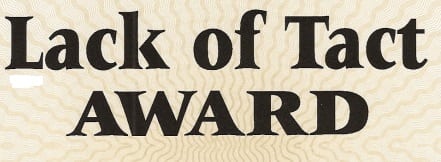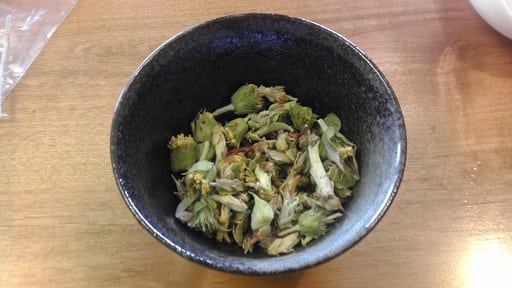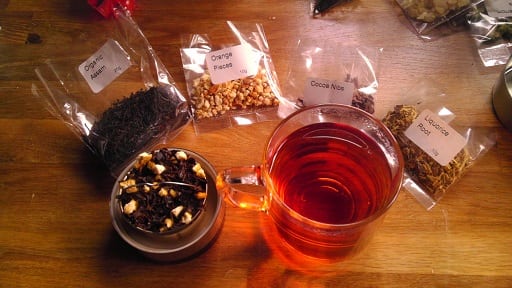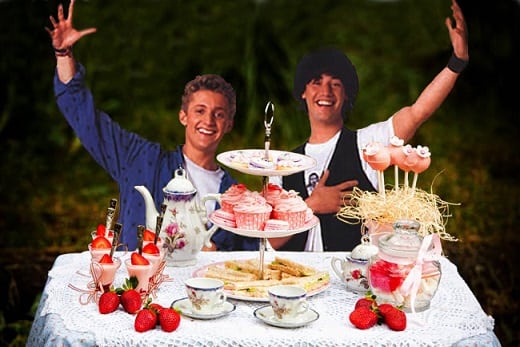White Tea Week, Day 7: “White Buds Pu-Erh”
Okay, technically, this is cheating. It’s not really a white tea. Hear me out.
Just yesterday, I covered aged white tea. The process for that is relatively simple. Find a cool, dry place to store it, keep it covered airtight…and forget about it for five years. Awesomeness can – and may – ensue. If pressed into a beengcha (tea cake), even better. Gives one something to work for. What I haven’t covered, though, is the difference between aged white tea and pu-erh made from white tea leaves.
Sheng (or raw) pu-erhs are made from tea leaves that have been wok (or pan) fired then sun-dried. After that, they’re either compressed into cakes or other shapes, and ferment naturally on their own. The other type of pu-erh – shou (or cooked) – goes through a more…impatient process. Machine-tumbling and wet-piling. Think of those like composting mulch, then you’ll get the idea.

Okay, that’s not entirely fair. Cooked pu-erhs do take on some interesting characteristics once given a chance to age naturally after the initial compostumble-stuff. The gold medal, though, goes to the shengs. They’re my chosen form of pu-erh-ing. And we won’t even go into the larger family of heicha (dark tea), of which pu-erh is a part. Too much ground to cover.
(Sidenote: Yes, I’m skating over a lot of pu-erh knowledge for the sake of witticism. I’m no expert on the subject. Just a taster.)
The first “white tea” pu-erh I ever tried was almost entirely by accident. A local tearoom was carrying something they dubbed “Silver Needle” pu-erh. Back then, my weird tea radar was in its infancy. While I was eager to try it, I didn’t just stop my life in order to hunt it down. I waited a good week, at least.
It was exquisite. And since then, I had three or four others that met similar approval. Most of these were five-year or ten-year teas. What I was really curious about was how a white bud pu-erh held up somewhere closer to infancy. By a twist of fate, a White Buds Sheng Pu-erh (2011) was hidden among the Taiwanese whites I received from Norbu Tea.

Image mooched from Norbu Tea
The leaves were definitely white buds to the core. All light green needles, young forest green leaves leaves, and fuzzy excellence with a smell that could best be described as…uh…sheng-y. There were more needles than straight-up leaves, though, which was a plus. Subtler than most other raw pu-erhs, I really couldn’t make out much other than grass, wilderness, wood, and a smidge of something almost stonefruity. It reminded me of straight-up White Peony that’d been in storage for a couple of years.

For brewing, I boiled water and approached it like any other sheng pu-erh. Gongfool-style, all the way. I took a hefty enough chunk to fill a teaspoon, and placed it in a 6oz. gaiwan. Three successive infusions were a good enough judge of character, each one at about thirty-to-forty seconds.
Over the course of three infusions, the needled leaves had broken apart and infused to varying degrees of yellow. The first infusion was obviously the lightest, but the other two were around the same shade of pale gold. The real difference between the three lay in the flavor.
Each one had the citrus and grass lean in common. But the further down the white rabbit hole I went, the bolder the profile became. Lemons, forest, and hay were the dominant nuanced notes on display. Smoke was a trait that showed up in the underpinning. Not that I minded.

Even after three years of aging, the white tea profile still dominated the flavorscape of this still-young pu-erh. Some wine notes were emerging, but only in the aftertaste. Given another three years of resting on its pressed-leaf laurels, I’m sure more fermented characteristics would emerge. As for now, it was like a white tea that could take a pu-erh punishment. I’ll drink to that.
*****
And that, folks, is the end of White Tea Week. What did I learn? Well, nothing I didn’t already know. White tea is awesome. It got me started on the road to orthodox tea appreciation, and it still holds the crown.
What did I benefit from seven days’ worth of white tea blogging? My teeth have never been whiter. I was fighting a cold/flu-plague, but it seems to have retreated thanks to all the antiviral badassery from the teas. And lastly, my outlook has never been whiter. Er, I mean brighter!
In the end, it’s nice to know what’s out there. I’m reassured that so many countries are playing with the tea type. After all, I’m only getting started.

Image copyright Oleg Kozlov – iStockphoto.com



















































 As an unemployed person, one of the most difficult tasks is literally getting out of bed. Let’s face it, joblessness is depressing. Why does someone want to get started when it feels like their world is ending? The key is a self-fueled kick in the pants.
As an unemployed person, one of the most difficult tasks is literally getting out of bed. Let’s face it, joblessness is depressing. Why does someone want to get started when it feels like their world is ending? The key is a self-fueled kick in the pants.
 If you – fair reader – are anything like me, you hate writing about yourself in a clinical manner. The urge to self-deprecate is a strong one. Same with wanting to sell yourself short. Some have a magical grasp of inflating their accomplishments; I am not one of them. Plus, I’m not very good at summarizing my abilities and accolades (whatever they are) concisely.
If you – fair reader – are anything like me, you hate writing about yourself in a clinical manner. The urge to self-deprecate is a strong one. Same with wanting to sell yourself short. Some have a magical grasp of inflating their accomplishments; I am not one of them. Plus, I’m not very good at summarizing my abilities and accolades (whatever they are) concisely.
 As much as I hate to admit it,
As much as I hate to admit it, 
 Congrats! You’ve made it to an actual interview. Someone has taken the time out of their busy schedule to interrogate you for thirty minutes to an hour. But you don’t want to come across as a complete tool. (Unless they’re looking for someone useful.)
Congrats! You’ve made it to an actual interview. Someone has taken the time out of their busy schedule to interrogate you for thirty minutes to an hour. But you don’t want to come across as a complete tool. (Unless they’re looking for someone useful.)
